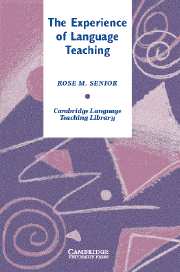Book contents
- Frontmatter
- Contents
- List of figures
- Acknowledgements
- Preface
- Introduction
- 1 Establishing a framework for the book
- 2 Training to be a language teacher
- 3 Becoming a committed language teacher
- 4 Establishing the learning environment
- 5 The diversity of the language classroom
- 6 Managing individuals
- 7 Teaching flexibly
- 8 Vitalising the language class
- 9 Maintaining the classroom community
- 10 Frustrations and rewards
- 11 What drives language teachers
- 12 Towards a teacher-generated theory of classroom practice
- References
- Index
5 - The diversity of the language classroom
Published online by Cambridge University Press: 05 November 2012
- Frontmatter
- Contents
- List of figures
- Acknowledgements
- Preface
- Introduction
- 1 Establishing a framework for the book
- 2 Training to be a language teacher
- 3 Becoming a committed language teacher
- 4 Establishing the learning environment
- 5 The diversity of the language classroom
- 6 Managing individuals
- 7 Teaching flexibly
- 8 Vitalising the language class
- 9 Maintaining the classroom community
- 10 Frustrations and rewards
- 11 What drives language teachers
- 12 Towards a teacher-generated theory of classroom practice
- References
- Index
Summary
The previous chapter focused on how language teachers in western contexts go about establishing the kinds of classroom environments that they consider most suitable for language practice. It drew attention to the fact that language teachers value informal classroom atmospheres, encouraging their students to behave naturally and spontaneously as they engage in whole-class activities and small-group interactive tasks. The chapter identified the kinds of communicative tasks that language teachers regularly set up in their classrooms, and showed how language teachers typically behave in order to set the students in their classes at ease.
The focus of the present chapter is on the raw material of language classes: the students themselves. Section 5.1 describes the wide range of backgrounds, learning experiences and expectations that adult learners typically bring with them to their classes – and which make each language class a unique entity that can never be exactly replicated. Section 5.2 describes the kinds of factors that can impinge on the ability of individuals to maximise their learning opportunities, while Section 5.3 describes some of the ways in which students can aggravate one another within the confines of the language classroom.
The data for this chapter have been gathered in Australia, a country with a tradition of providing English language tuition to a range of students including migrants, refugees, fee-paying students on short intensive courses and students from non-English-speaking backgrounds who aspire to enter Australian tertiary institutions. The majority of students studying on intensive English language courses in Australia come from Asian countries, with the minority coming from a range of other countries around the world.
- Type
- Chapter
- Information
- The Experience of Language Teaching , pp. 103 - 118Publisher: Cambridge University PressPrint publication year: 2006

